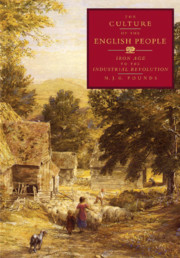Book contents
- Frontmatter
- Contents
- List of illustrations
- List of tables
- Preface
- List of abbreviations
- Map of traditional counties, with abbreviations, as used in this book
- Introduction
- 1 The view from Danebury
- 2 Roman interlude
- 3 House and household
- 4 Heat, light and insecurity
- 5 The house furnished
- 6 Food, its production, preservation and preparation
- 7 In sickness and in death
- 8 The community of parish and village
- 9 The family
- 10 The culture of cities
- 11 The foundations of popular culture
- 12 Conclusion: the end of popular culture
- Notes
- Index
7 - In sickness and in death
Published online by Cambridge University Press: 06 July 2010
- Frontmatter
- Contents
- List of illustrations
- List of tables
- Preface
- List of abbreviations
- Map of traditional counties, with abbreviations, as used in this book
- Introduction
- 1 The view from Danebury
- 2 Roman interlude
- 3 House and household
- 4 Heat, light and insecurity
- 5 The house furnished
- 6 Food, its production, preservation and preparation
- 7 In sickness and in death
- 8 The community of parish and village
- 9 The family
- 10 The culture of cities
- 11 The foundations of popular culture
- 12 Conclusion: the end of popular culture
- Notes
- Index
Summary
Times of great sickness and illnes, agues abounding more then in all my remembrance, last yeare and this also; feavers spotted rise in the contry; whether it arise from a distempered and infected aire I know not, but fruite rottes on ye trees as last yeare, though more, and many cattle die of ye murraine.
Ralph Josselin's Diary, August 1647People in pre-industrial Britain saw themselves as living always in ‘the valley of the shadow of death’. Life was dominated by the prospect of death. Disease was rampant; malnutrition general, accidents frequent, and the expectation of life short.1 Nowhere was this expressed more powerfully that in medieval iconography and illustration. And, since the only examples that most people were ever likely to see, at least before the later sixteenth century, were to be found in their local parish churches, it is to wall-paintings and stained glass that we must turn in the first instance. They all display a restricted number of motifs. Window-glass was made and the designs composed in urban workshops, but wall-paintings were spread over the rendered interior walls of churches by craftsmen who travelled from parish to parish with their limited repertoire of motifs which they repeated with little modification from one church to another.
Representations of mortality
These motifs were redolent of death. The wheel of fortune was a symbolic representation of the ages of human life, ending with death.
- Type
- Chapter
- Information
- The Culture of the English PeopleIron Age to the Industrial Revolution, pp. 220 - 254Publisher: Cambridge University PressPrint publication year: 1994



